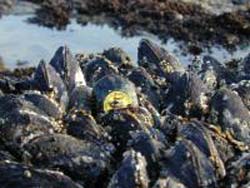Same species responds differently to same warming, depending on location

A "robomussel," actually an intertidal temperature data logger, can mimic the thermal characteristics of an individual mussel and record temperature data at 10-minute intervals for up to seven months. Credit: University of Washington
Based on current trends for both air and water temperatures, by 2100 the body temperatures of California mussels — found along thousands of miles of coast in the northeast Pacific Ocean and not just in California –- could increase between about 2 degrees F and 6.5 F depending on where they live.
For areas where mussels already are living close to the edge, chances are that increases of 6.5 F will kill them, researchers say.
Unlike humans, the body temperature of marine animals such as mussels is regulated by the temperature of the air and water around them –- and it’s not the simple 1-degree warmer and 1-degree rise in body temperature that has been assumed, says Sarah Gilman, a University of Washington postdoctoral researcher and lead author of a paper appearing online June 5 through June 9 in the Early Edition of the Proceedings of the National Academy of Sciences.
For the first time, Gilman and her co-authors show that even if the weather warms the air and water the same amounts in one area as another, the actual effect on mussel body temperatures can vary because of local climate. For example, in Washington, air temperature appears to be more important in driving mussel temperature while in southern California, water temperature is the more important factor.
“This is an important consideration for conservation biologists trying to understand how a species might handle global warming and to those proposing reserves in marine environments,” Gilman says. “Protected areas will need to be in places where marine animals can live in the face of climate change.”
In work funded by the National Science Foundation, NASA and the National Oceanic and Atmospheric Administration, data loggers –- tiny computers with thermometers -– have been used to collect information in mussel beds. The data loggers, nicknamed “robomussels,” record the temperatures being experienced by the surrounding mussels every 10 minutes for months at a time.
A new computer model described in the paper relates the collected data to meterological information researched by Gilman. Using the model and applying a moderate air temperature warming of 2.25 F across the California mussels’ range resulted in mussel body temperature increases ranging from just under 2 F to just over 2 F depending on the habitat. Modeling a more extreme air warming of 7.5 F by 2100 across the mussels’ geographic range resulted in body temperature increases ranging from about 4 F to 6.5 F. “We have only contributed ’step one,’ the tie between climate and body temperature,” says co-author Brian Helmuth, associate professor of biological sciences at the University of South Carolina. “With our model we can predict temperatures based on satellites and computer models of climate change. The next step is to work with physiologists to see just what body temperatures California mussels can handle.
“Unfortunately, from what we can tell so far, California mussels are likely already pretty close to the edge, at least at some places along the West Coast. Our study suggests that climate change may start to kill marine animals in some unanticipated places. However, we can use modern technologies such as remote sensing to forecast some of these impacts.”
Intertidal habitats, places uncovered at low tide and flooded with water at high tide, have long served as models for investigating the effects of climate on species distribution and monitoring the consequences of climate change for natural ecosystems, write Gilman, Helmuth and another co-author David Wethey, professor of biological sciences at South Carolina. In the course of some low tides, intertidal organisms such as California mussels –- or Mytilus californianus -– may already experience temperatures near the maximum they can tolerate, so they are thought to be a good organism to watch for responses to climate change.
“The bottom line is, as humans, we tend to have this very biased view of the world and we forget that changes in air temperature, which tend to have only very small direct effect on us, can have huge effects on other species,” Helmuth says. “This is especially true for species that have temperatures driven by the sun, wind and air temperature, much as the way your car heats up on a sunny day.”
Media Contact
More Information:
http://www.washington.eduAll latest news from the category: Life Sciences and Chemistry
Articles and reports from the Life Sciences and chemistry area deal with applied and basic research into modern biology, chemistry and human medicine.
Valuable information can be found on a range of life sciences fields including bacteriology, biochemistry, bionics, bioinformatics, biophysics, biotechnology, genetics, geobotany, human biology, marine biology, microbiology, molecular biology, cellular biology, zoology, bioinorganic chemistry, microchemistry and environmental chemistry.
Newest articles

Scientists transform blood into regenerative materials
… paving the way for personalized, blood-based, 3D-printed implants. Scientists have created a new ‘biocooperative’ material based on blood, which has shown to successfully repair bones, paving the way for…

A new experimental infection model in flies
…offers a fast and cost-effective way to test drugs. Researchers at the Germans Trias i Pujol Research Institute and Hospital have reinforced their leading role in infectious disease research by…

Material developed with novel stretching properties
KIT researchers produce metamaterial with different extension and compression properties than conventional materials. With this material, the working group headed by Professor Martin Wegener at KIT’s Institute of Applied Physics…



